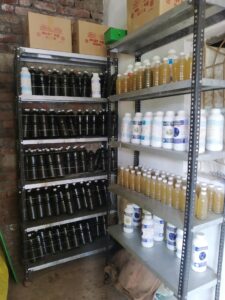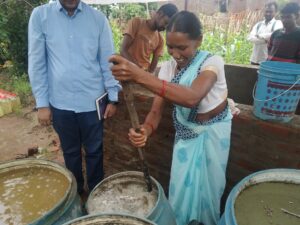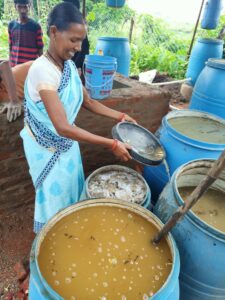Promoting bio-resource centers as a model to improve soil health and fertility

Article by Marina Vara Gutiérrez, Regenerative agriculture expert, AidEnvironment
India has seen rapid growth in the use of chemical fertilizers and pesticides over the last decade as the country’s population increased. The states of Madhya Pradesh and Jharkhand, although traditionally lagging behind the use of chemical and mechanized agriculture, have not been an exception to this trend, especially in areas with good road connectivity. The overuse of chemical fertilizers is generating negative consequences for both soil quality and human health.
In recent years, there have been a number of Indian farmers adopting regenerative agricultural practices as a way to counter the negative effect of decades of agricultural chemical input. The goal of regenerative agriculture is to restore soil health and fertility by introducing a set of integrated farming practices. Some of these practices are the combined use of bio-inputs (bio-fertilizers and bio-pesticides) and organic compost produced with locally available natural resources.
But what are biofertilizers, biopesticides, and compost? And how does their combined use improve soil health?
Biofertilizers can be defined as biological preparations of active microorganisms that promote plant growth by improving plant nutrient uptake. They enhance soil productivity by fixing atmospheric nitrogen, solubilizing soil phosphorus, and stimulating plant growth. Biopesticides are compounds that are used to kill, damage, or repel pests. The term can refer to products containing biocontrol agents such as natural organisms or substances derived from natural materials (animals, plants, bacteria, or certain minerals). Compost is a soil amendment made from decayed carbon-based matter like vegetables, manure, grasses, dead leaves, woody debris, etc. Compost addition to soils influences the chemical, physical, and biological properties of the soil. For example, it improves aeration and the moisture retention capacity of the soil while enriching it with essential nutrients that enhance the soil microbial activity. The combined use of the three above mentioned products in a farm plot contributes to more plant nutrient availability, better soil aeration, better moisture retention capacity of the soil and the reduced use of chemical substances that will alter soil properties. Overall, these contribute to improved soil health.
With this in mind, the Green Transformation Pathways (GTP) project is being piloted in rural areas facing soil health and fertility-related challenges, as a model of bio-resource centers (BRCs) In these areas, access to information about regenerative agricultural practices, bio-inputs, and organic compost is limited or nonexistent, and therefore the BRCs can act as information and distribution centers of soil health-friendly products and practices.
BRCs can be a great tool to foster the use of regenerative farming practices and improve soil health in the states of Madhya Pradesh and Jharkhand. They can be especially successful in remote areas that lack good road connectivity which therefore limits access to chemical inputs for agriculture. Most BRCs in the project areas are in the pilot phase with the objective to improve the model and make it replicable in other areas. It is important to focus on reducing the labor involved in the production process of bio-inputs and compost, as well as homogenizing the preparation process and the ingredients of each product (biofertilizers, biopesticides and compost.) Other points of focus while in the pilot stage are advising farmers on how to integrate the use of the products produced in the BRCs into their cropping calendars, and developing a business plan that will make the BRC model profitable and self-sustained.
During the coming months, AidEnvironment, together with our partners (PRADAN, FES and MetaMeta) will contribute to the fine-tuning and upscaling of the BRC model to produce bio-fertilizers, bio-pesticides, and compost for better soil health for those in the GTP program.






